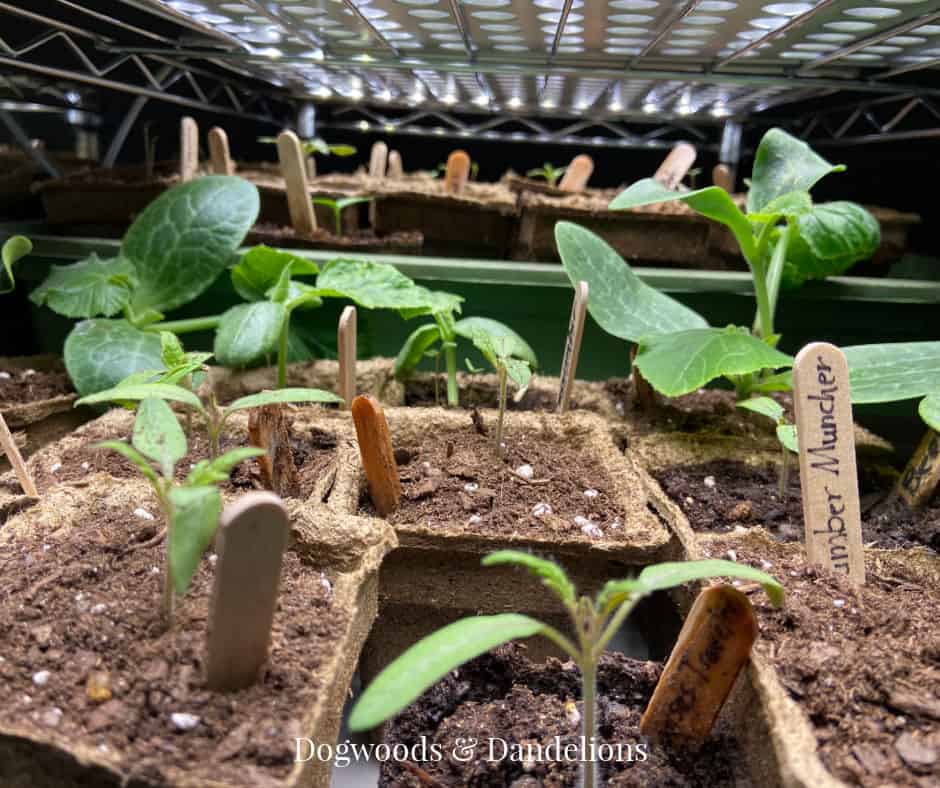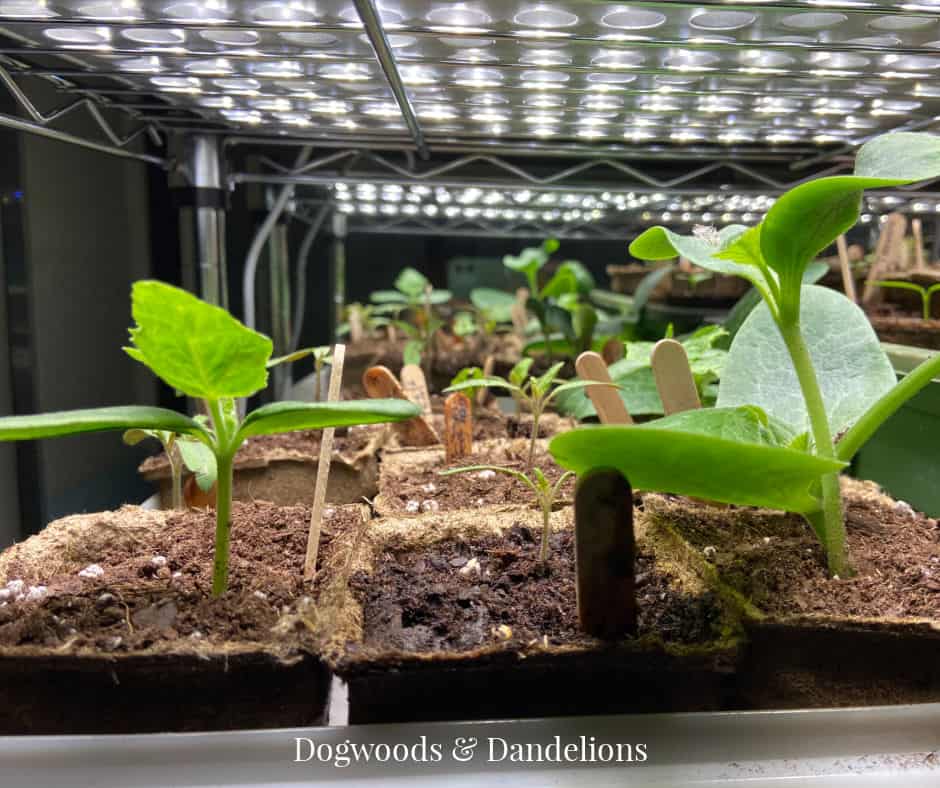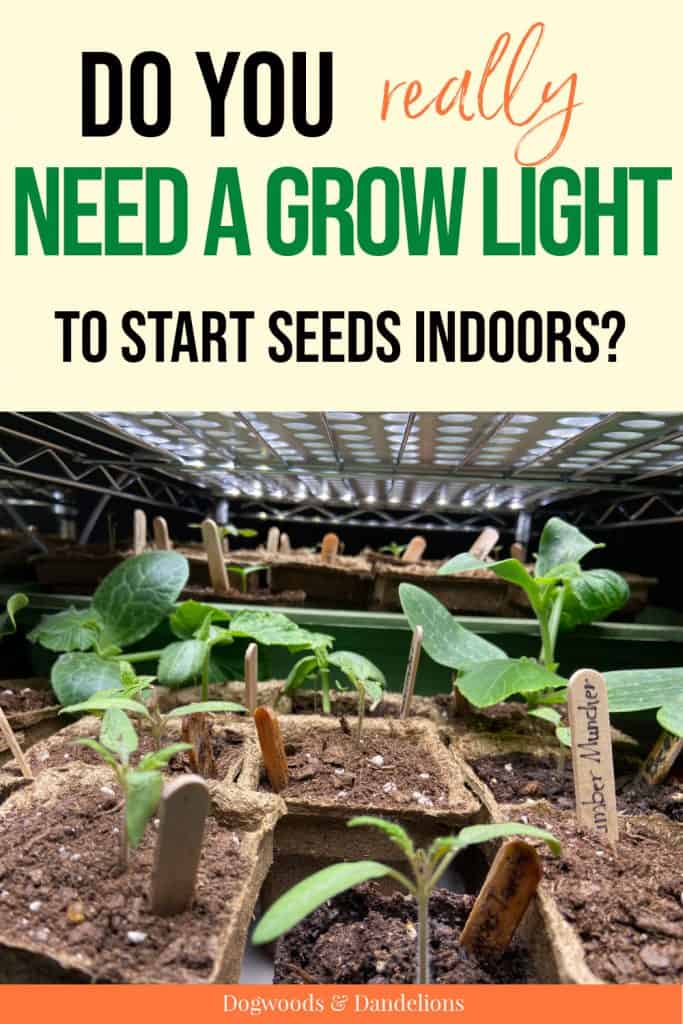Best Grow Lights for Starting Seeds Indoors
Inside: The best grow lights for starting seeds indoors.
One of the most common questions I receive about indoor seed starting is “Do I really need a grow light to start seeds inside?”
Growing a garden from seed can be a cost-effective way to get lots of produce. However, if you plan on growing plants from seed, you will almost certainly need a grow light. Understanding the different types of lights will help you choose the best grow lights for starting seeds indoors.

Affiliate Disclosure: Please note that some of the links in this article may be affiliate links and I may receive a small commission if you purchase something through a link. It will not change your cost. As an Amazon Associate, I earn from qualifying purchases. For more information, see my disclosures page.)
Do I Need a Grow Light to Start Seeds Indoors?
Do you really need a grow light to start seeds indoors? The short answer is yes. Yes, you really do. Without a grow light, your seedlings will most likely not receive enough natural sunlight to grow properly without getting leggy.
Even in the winter, a south-facing window usually does not provide enough sunlight to grow seedlings. The majority of your warm-weather summer vegetables need about 14 hours of sunlight each day to support plant growth.
During the winter, most homes don’t receive that much natural light during the day. The best way to provide the light intensity needed for any kind of indoor gardening is to purchase grow lights.
If you must grow something without a grow light, your best bet is to grow some leafy greens. Vegetables such as lettuce and kale don’t require as much sunlight to grow as tomatoes and beans.
For other vegetables that you can grow with less light read “Vegetables to Grow in the Shade.“
Types of Grow Lights for Starting Seeds Indoors
There are several types of grow lights that can be used for starting seeds indoors and there are pros and cons of each. The type of light you choose does make a difference when growing any kind of indoor plants.
Incandescent Lights
Incandescent light bulbs are the cheapest type of bulbs on the market but they definitely aren’t the best for growing plants. They get hot and can overheat your plants in a hurry.
Plants tend to get leggy under incandescent fixtures too because they don’t deliver the high-intensity light plants need for good growth. Most incandescent bulbs also don’t deliver the full spectrum of light the plants require. And putting the plants too close to the bulbs can burn the leaves.
Fluorescent Light Bulbs
Fluorescent lights are better than incandescent bulbs. Fluorescent bulbs are commonly found in shop lights. They stay much cooler and contain a wider spectrum of light than incandescent bulbs.
Fluorescent lighting is a great choice if you are on a budget. While not quite as good as the LED grow lights, they will definitely work to grow healthy plants. I used shop lights for years with no major problems. You can usually find inexpensive fluorescent lamps online or at home improvement stores.

LED Lights
LED lights are my preferred lights to use to start seeds indoors. If you aren’t familiar with the term LED it means light-emitting diodes.
You can find LED lights with full spectrum colors that mimic the sunlight. They use less energy and create less heat than other types of lights, making them the best choice for indoor gardeners.
The LED grow lights that I use contain both blue and red bulbs. The blue light helps promote leaf growth, while the red light helps promote growth during the flowering stage. The only downside to these bulbs is that they emit a purplish glow.
Before buying any type of LED light, decide how many plants you plan to grow. If you are starting seedlings, it’s always a good idea to start a few extra in case some don’t germinate.
However, don’t start so many seeds that you don’t have room to plant them in your garden. (Unless you plan to give them away.)
It is easy to start a lot of seeds because they don’t take up much room at first. But you need to be prepared to repot those plants into larger pots and still have room for them under your grow lights until it is time to harden them off and transplant them outdoors in the garden.

How To Set Up Your Grow Lights
I have a pretty simple set up when it comes to grow lights. And you will definitely save money if you take a do-it-yourself approach.
I purchased an inexpensive metal shelf to hold my plants. I used to hook my grow lights (shop lights) on the shelves with a paper clip. (I told you it was diy.) I used this setup for at least 5 years, maybe more.
Last year, however, I upgraded to some LED full-spectrum grow lights. While you can hang these lights, (They come with everything you need to hang them.) since they are flat panels, they worked perfectly placed face down on the shelf.
I noticed much better growth and less legginess with the LED lights. We have our grow shelves in the laundry room so the purplish light isn’t really an issue.
I recently experimented with some grow lights with yellow bulbs in a similar style. While the yellow LED lights don’t cast such a garish light, I feel like the plants grow best under the red and blue LED lights.
If you are using the grow lights in a common area where you will be frequently, I would recommend the yellow ones. However, if you are starting your seeds in an out-of-the-way location (garage, laundry room, etc.) I would go with the red and blue ones.
How Far To Keep LED Grow Lights from Plants?
Once you’ve got your grow area set up and some seedlings started, it is a good idea to go ahead and turn the lights on, even if the plants haven’t germinated yet.
Many seedlings require light to germinate, so having the lights already on will ensure they receive enough light.
As soon as the seedlings sprout, you should keep the grow lights approximately 2 inches above the top of the plants. As the plants grow you should raise the lights so that they remain just above the plant canopy.
Allowing too much distance between the light system and the plants will cause the plants to become too tall without properly developed stems. This leads to “leggy plants” and is impossible to overcome in most vegetable starts.
But if the light fixtures are too close to the top of the plants you may experience light burn on your vegetables and flowers. Light placement is important.
It is a good idea to check your plants daily so that you can move the light if needed. Remember the ideal distance from the top of your plants to the light is 2″ for optimal plant growth.
Can You Use Grow Lights to Grow Vegetables Indoors In the Winter?
The LED grow lights are great for growing vegetables indoors during the winter too. I regularly grow leaf lettuce under my grow lights.
I’ve been able to harvest enough lettuce for quite a few salads by growing the lettuce under my light source. I cut the outer leaves and the inner leaves keep growing. I even use them in the summer when it is too hot to grow lettuce outdoors.
While you obviously can’t grow all your produce indoors, it can be fun to grow a few vegetables or herbs to add some freshness to your winter meals.
If you want to grow a variety of vegetables or herbs during the winter, you might want to look into the AeroGarden. These are little grow stations that grow vegetables and herbs hydroponically.
Most come as a complete kit that includes everything you need to set up the hydroponics and an attached grow light. AeroGardens are a fun way to grow something with your kids too. I linked to the basic model, but there are many different kinds to choose from.

I have a much older model that I’ve used for years. I’ve grown herbs in mine and even a small tomato plant. It was the only year I beat my Mom in harvesting the first tomato from our gardens.
Yes, Grow Lights are Necessary to Start Seeds Indoors
I hope by now that you understand that using grow lights really is one of the most important factors for success if you want to start seeds indoors. Without the right amount of light, and the light source the optimal distance from the top of the plant, your seedlings will struggle to get enough bright light to grow healthy and strong.
And weaker plants don’t do as well when you go to transplant them into the garden in the spring which can mean a delayed harvest or even some dead plants.
So while artificial lights may seem like an extra expense when growing a garden, they are the best thing you can purchase to ensure success if you plan on starting seeds or growing a garden indoors.
Related Posts

Meet Julie
I’m a farm girl born and bred in North Carolina. I’ve been growing a vegetable garden for over 20 years (and helping my Mom grow hers even longer). I’ve been raising chickens in my bathtub and backyard for 12+ years. I believe that homegrown food can be made simple. Let’s get started.

